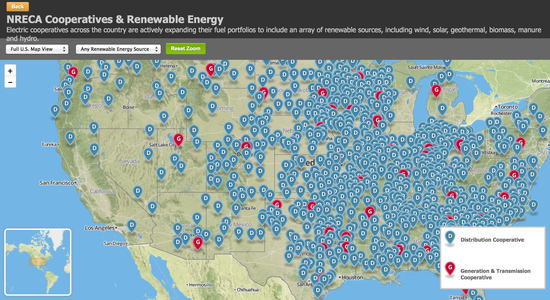Rural electric co-ops got their start more than 70 years ago thanks to a smart piece of public policy -- the New Deal.
Farmers and other rural residents, the thinking behind President Franklin Delano Roosevelt's Rural Electrification Act went, should be entitled to the same technological advancements that came with the modern convenience of electricity as any other American in any other part of the country.
Today, thankfully, many rural electric co-ops are working on ways to bring the next phase of electricity -- clean, renewable energy -- to their members, giving farmers and other residents of rural areas the same sort of access to solar, wind and other forms of clean energy as the rest of America.
Just look no further than the website of the National Rural Electric Co-operative Association (NRECA) for proof of how rural co-ops are embracing clean energy with success.
On the association's interactive map, it's hard to find a spot in America with a co-op that isn't adding clean, renewable energy.

Oddly enough, NRECA has launched an attack ad campaign on another smart piece of public policy -- the EPA's Clean Power Plan -- that is designed to foster growth and ultimately bring down prices for clean, renewable energy at co-ops and other utilities nationwide.
It's hard to understand why the trade group for co-ops is trying to stop a policy that will make it easier and more lucrative for co-ops and their members to gain access to clean, renewable energy and the economic benefits that come with it.
Just a couple of months ago, in fact, NRECA's chief executive joined President Obama in California touting the importance and the cost-effectiveness of clean, renewable energy.
"Across the country, member-owned, not-for-profit rural electric cooperatives are leveraging the benefits of cost-effective solar for their consumer-members," said NRECA CEO Jo Ann Emerson. "True to the principle of putting members first, co-ops are leading in the development of community solar, an innovation that allows more consumers access to the benefits of solar."
States that implement strong plans to meet the carbon pollution reductions outlined in the EPA Clean Power Plan almost assuredly will attract new private-sector investments in solar, wind and other clean, renewable energy sources.
We've already seen evidence that this sort of policy works. States that have strong renewable portfolio standards, for instance, almost always lead in clean energy and clean transportation job creation.
By moving to renewable energy, rural electricity co-ops can modernize their power supplies just like any big, investor-owned utility. By adding solar, wind and other clean energy sources to their supply mix, co-ops also create local jobs and generate home-grown power -keeping local dollars local, instead sending them to out-of-state coal companies.
Some examples of rural co-ops leading the way:
*In St. Ansgar, Iowa, Heartland Power is building one of the biggest solar projects in the state. With 1,200 solar panels, the project will provide the co-op's 5,200 members with clean, renewable electricity that's produced right in their neighborhood.
*A few hundred miles south, in Johnson County, Iowa, Farmers Electric Co-op is developing Iowa's largest solar project - a nine-acre array that has earned the co-op the moniker "America's Most Progressive Utility."
*In Illinois, the Illinois Rural Electric Cooperative (IREC) owns a 365-foot wind turbine that generates utility-scale electricity for its customers. The Vestas 1.65 MW wind turbine generates enough electricity to power 500 homes. According to IREC's general manager, the wind resources in Pike County could support another 100 turbines. A project that size could add $5 million- $7 million to the local tax base, generate $1.5 million in maintenance work, and stimulate $5.25 million in economic activity within the county.
*In Ohio, Buckeye Power has added to its generating capacity with a number of different renewables projects, including a 4.45 MW agricultural biogas project, a 30 MW wind energy project and a 6.4 MW landfill methane generation project.
FDR's Rural Electrification Act and the New Deal revolutionized our nation's economy -- creating jobs, economic benefits and modern advances along the way.
The EPA's Clean Power Plan similarly promises to modernize our electricity supply -- creating jobs, economic benefits and modern advances along the way.
Washington lobbyists at NRECA for whatever reason may want to keep us in the dark about the economic benefits that will come with the Clean Power Plan.
But fortunately, many rural electric co-ops around the country see the light.
